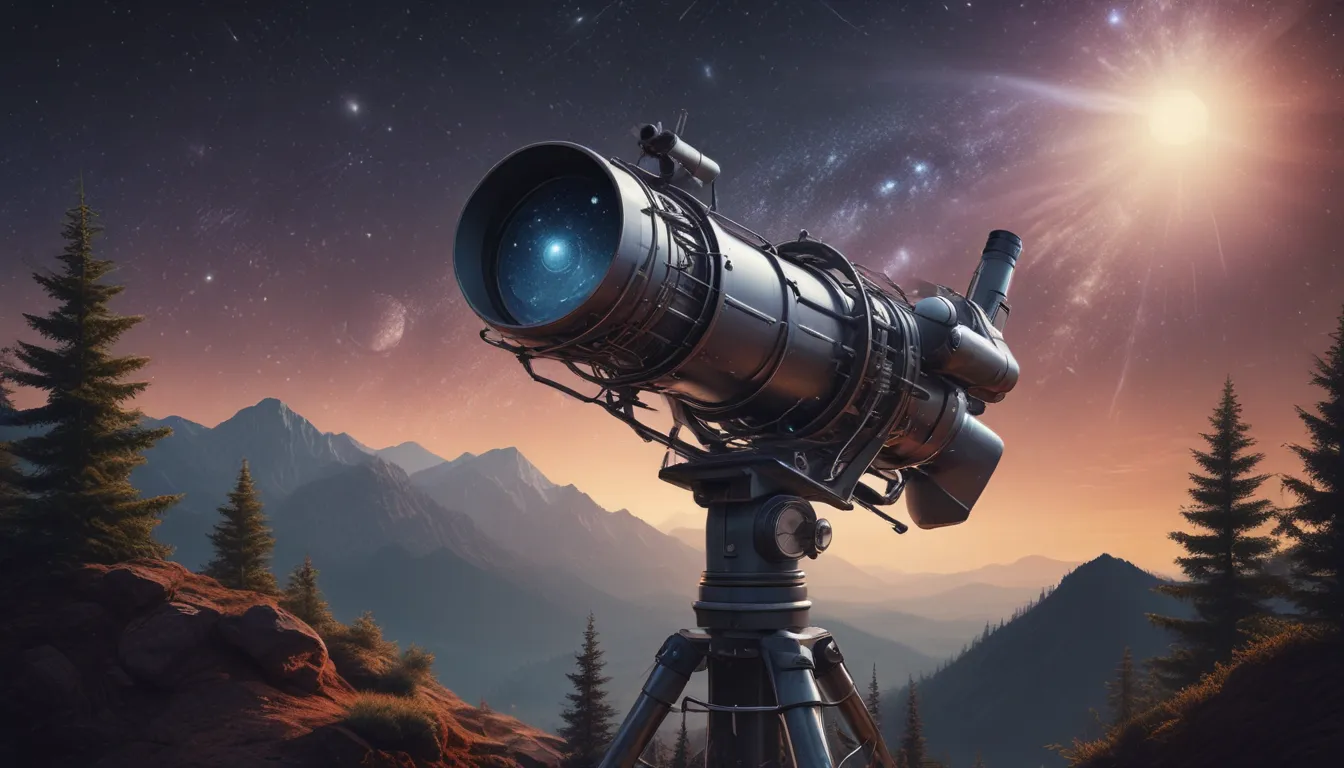The pictures we use in our articles might not show exactly what the words say. We choose these pictures to make you interested in reading more. The pictures work together with the words but don’t take their place. The words still tell you the important facts.
Radio telescopes are magnificent technological marvels that have opened up a whole new world of possibilities for humanity to explore the vast depths of the universe. These incredible instruments use radio waves to detect and study celestial objects, offering us insights into distant galaxies, stars, and even the remnants of the Big Bang. As we take a closer look at 15 unbelievable facts about radio telescopes, prepare to be amazed by the wonders of the cosmos that these instruments have unveiled.
Unveiling the Wonders of the Universe
- Radio telescopes have the unique ability to detect invisible objects like distant galaxies, pulsars, quasars, and remnants of the Big Bang, expanding our understanding of the universe beyond what the naked eye can see.
- The collapse of the Arecibo Observatory in 2020 marked the end of its 50-year reign as the world's largest single-dish radio telescope, demonstrating the continuous evolution of astronomical technology.
The Birth of the Radio Telescope
In the 1930s, Karl Jansky, while working for Bell Labs, invented the radio telescope. Initially designed to detect and study radio waves from cosmic objects, this groundbreaking invention revolutionized the field of astronomy.
Unraveling Cosmic Mysteries: The Largest Radio Telescope
The Arecibo Observatory in Puerto Rico reigned as the largest single-dish radio telescope for over half a century until its collapse in 2020. With a diameter of 305 meters, this colossal telescope played a pivotal role in numerous astronomical discoveries.
Seeing Beyond the Visible: Detecting Invisible Objects
Unlike optical telescopes, radio telescopes can capture signals emitted by objects that are invisible to the naked eye, such as distant galaxies, pulsars, quasars, and even remnants of the Big Bang. This ability to penetrate the unseen has opened new horizons for astronomers.
A 24/7 Window into the Universe
Operating day and night, unaffected by weather conditions, radio telescopes provide astronomers with the opportunity to observe celestial objects continuously. This uninterrupted observation enables the gathering of consistent data for comprehensive studies.
The Enigmatic “WOW Signal”
In 1977, the Big Ear radio telescope at Ohio State University picked up a mysterious, strong radio signal from outer space that lasted 72 seconds. Dubbed the "WOW signal," its origin remains a puzzle, sparking intrigue and curiosity in the scientific community.
Capturing the Unseen: The First Black Hole Image
In 2019, an international team of scientists utilized the Event Horizon Telescope, a network of radio telescopes, to capture the first-ever image of a black hole. This historic achievement validated Albert Einstein's theory of general relativity and broadened our understanding of these enigmatic cosmic entities.
Peering into the Cosmic Past: Cosmic Background Radiation
Through the study of cosmic background radiation, the faint afterglow of the Big Bang, radio telescopes have shed light on the early universe and the formation of galaxies. This invaluable data provides critical insights into the origins and evolution of the cosmos.
Ears to the Skies: The Search for Extraterrestrial Intelligence
Radio telescopes play a vital role in the Search for Extraterrestrial Intelligence (SETI), listening for potential signals from intelligent civilizations beyond Earth. While no confirmed signals have been detected to date, this quest continues, fueled by the possibility of discovering extraterrestrial life.
Connecting the Dots: VLBI Technology
Very Long Baseline Interferometry (VLBI) harnesses data from multiple radio telescopes worldwide to create a virtual telescope as large as the Earth. This innovative technique enables high-resolution imaging of celestial objects, offering intricate details of the universe's wonders.
The Quiet Zone of Discovery: The Green Bank Telescope
Located in West Virginia, the Green Bank Telescope features a unique "Quiet Zone," where all forms of electronic interference are minimized to facilitate precise astronomical observations. This pristine environment allows for unparalleled clarity in studying celestial phenomena.
Charting the Cosmic Terrain: Mapping the Universe
Radio telescopes have played a pivotal role in mapping the distribution of galaxies in the universe by observing radio emissions from distant galaxies. Through detailed mapping of the cosmic web, astronomers gain valuable insights into the structure and dynamics of the universe.
Cosmic Timekeepers: Pulsars as Celestial Clocks
Pulsars, highly magnetized rotating neutron stars that emit beams of electromagnetic radiation, act as precise cosmic clocks. Radio telescopes have been instrumental in the discovery and study of these celestial timekeepers, unveiling the intricacies of the cosmos.
The Future Unfolds: The Square Kilometre Array
The Square Kilometre Array (SKA), a cutting-edge radio telescope project under development, will comprise thousands of dishes across multiple continents. Upon completion, it will stand as the most extensive and sensitive radio telescope ever built, ushering in a new era of discovery in astronomy.
Navigating Challenges: Dealing with Radio Frequency Interference
Radio Frequency Interference (RFI) poses a challenge to radio telescopes, potentially disrupting the detection of faint signals from space. Efforts to mitigate RFI through shielding, signal processing, and selective frequency bands are crucial to preserving the integrity of astronomical observations.
The Journey Continues: Ongoing Discoveries with Radio Telescopes
Continuing to push boundaries, radio telescopes remain at the forefront of groundbreaking discoveries in astronomy. From exploring the cosmic microwave background radiation to studying exoplanets, these remarkable instruments continue to unlock the mysteries of the universe, enriching our understanding of the cosmos.
Delving into the Depths of Space
In conclusion, the 15 unbelievable facts about radio telescopes underscore the extraordinary capabilities and contributions of these astronomical instruments. From unraveling the enigmas of the universe to the pursuit of extraterrestrial life, radio telescopes play a pivotal role in expanding our cosmic knowledge and perspective.
FAQs: Exploring the Universe with Radio Telescopes
-
How do radio telescopes work?
Radio telescopes collect and analyze electromagnetic radiation emitted by celestial objects in the radio frequency range. By focusing incoming radio waves onto a receiver, these telescopes convert the waves into electrical signals for astronomers to study and interpret. -
What can radio telescopes detect?
Radio telescopes can detect a wide range of celestial phenomena, including distant galaxies, radio-emitting stars, pulsars, quasars, and cosmic microwave background radiation. Their ability to capture radio waves offers unique insights into the universe. -
How are radio telescopes different from optical telescopes?
Unlike optical telescopes that observe visible light, radio telescopes detect longer wavelengths in the electromagnetic spectrum. This capability allows them to capture radio waves and study objects that may be invisible or undetectable to optical telescopes. -
Where are some famous radio telescopes located?
Renowned radio telescopes worldwide include the Arecibo Observatory in Puerto Rico, the Parkes Observatory in Australia, the Green Bank Telescope in West Virginia, and the LOFAR (Low-Frequency Array) in the Netherlands. These telescopes have contributed significantly to astronomical discoveries. -
What is the future of radio telescopes?
The future of radio telescopes holds promise with projects like the Square Kilometre Array (SKA) advancing the field of astronomy. As technology evolves and new telescopes are developed, we can anticipate more groundbreaking discoveries and a deeper understanding of the universe.
Embracing the Unknown
Our exploration of the cosmos with radio telescopes continues to unveil the mysteries and wonders of the universe. As we journey through the vast expanse of space, these remarkable instruments guide us on a quest for knowledge and discovery. Embrace the infinite possibilities that lie beyond the stars, and let the wonders of the cosmos inspire your imagination.






